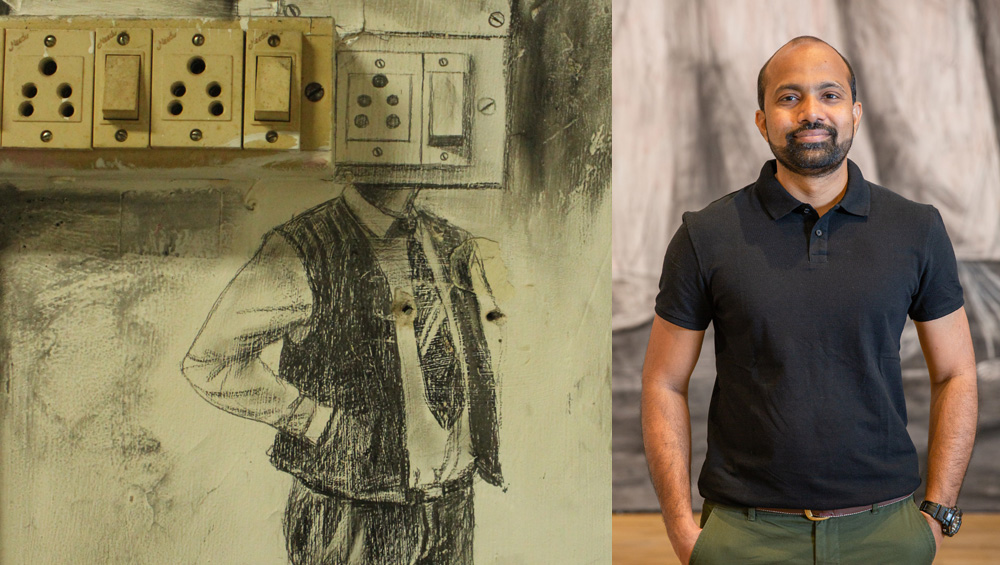
Prabhakar Pachpute. Image courtesy the artist.
by ANNA McNAY
The Indian artist Prabhakar Pachpute (b1986, Sasti, Chandrapur) is known for his large-scale charcoal wall drawings and combined installations, taking his background of coal mining, the associated landscapes and characters as their subject matter. His surrealist motifs and abstracted language are continuing to develop, and, when not grounded because of Covid-19, his participation in various international biennials and summits has led to travel and research opportunities, feeding him with further characters and stories to weave into his ultimately political works.

Prabhakar Pachpute. A march against the lie (IA), 2020. Acrylic and Multani clay on canvas, soil, 121 x 183 in. Photo: Experimenter, Kolkata. Courtesy the artist and Experimenter, Kolkata.
One of the six shortlisted international artists for the Artes Mundi 9 exhibition and prize, delayed from October 2020 and opening virtually on 15 March 2021, at the National Museum Cardiff, Pachpute talked to Studio International via Zoom from India.
Anna McNay: You were born in the Indian state of Maharashtra, at Sasti, Chandrapur, which is known as the City of Black Gold because its main industry is coal mining. Your family worked in the industry and, as a result, you later made this the subject – and medium – of much of your work. Can you tell me a bit about your memories of growing up and what the coal mines meant for you?
Prabhakar Pachpute: I have a lot of memories of my childhood and, whenever I return to my hometown, Sasti, they come back to me when I see the roads, the coal mines and, most importantly, when I feel the atmosphere. It’s a mixed community there. There are Maharashtrian people, people from south India and people from north India. There is a lot of cultural and linguistic exchange. I remember many traditions, such as for weddings or different kinds of ceremonies and, as a child, there were a lot of children’s games. These mostly used mining tools or mining equipment as “toys”. Sometimes we would just use a big tyre from a tractor or one of the bulldozers, a miner’s headlamp, old used batteries, wires, heavy boots, or play at hoop-rolling, which was the most popular game of all.
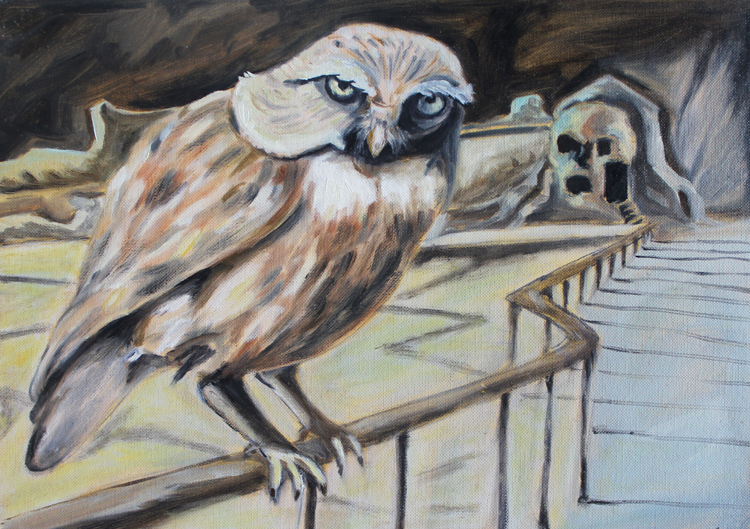
Prabhakar Pachpute. Museum Menageries (title for all the 40-paper works), 2020. Oil on paper
21 x 30 cm (each). Photo: the artist. Courtesy – the artist and Experimenter, Kolkata.
I studied in my hometown for only two years, but I also studied in different places in the Chandrapur district. Even when I had to live in different places for my studies, I was still connected to coal miners. When I began learning art – drawing, sketching, painting – and reading literature, especially Marathi literature, there was a drastic change in my thought process. All these observations from my childhood came back to my mind, and I started looking at them differently in terms of the landscape and surroundings, how it functions and what it means to us.
When I began to think about the characters in my drawings – such as the one with the binoculars, the one with the headlamp, or the manager – I saw their connection to my experiences. They are all very much related to what I have seen and lived. Also, the kinds of sound I use in my animations come from memories of that time period, too. But what I do now is juxtapose things: memories and what is happening now in real life.
AMc: Do you still live in the same region?
PP: No, I live in Pune, which is 700km from my hometown. But I have family there. My brother lives there, and my sister is there. A lot of my relatives still work in the coal mines.
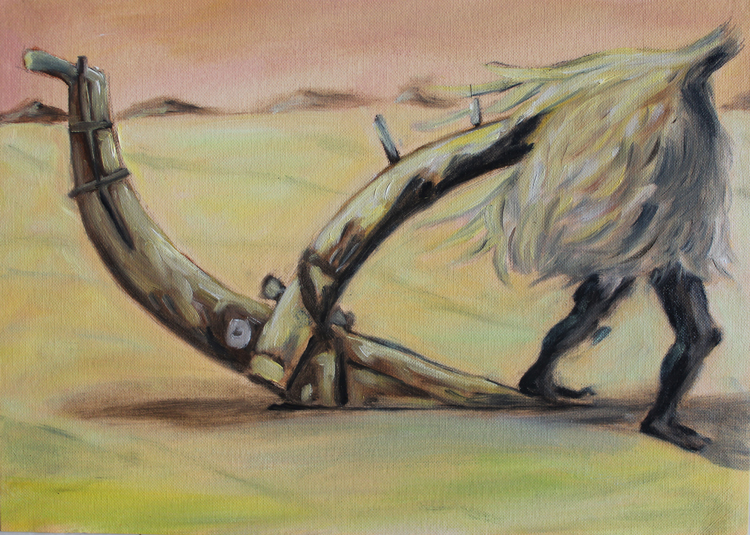
Prabhakar Pachpute. Museum Menageries (title for all the 40-paper works), 2020. Oil on paper
21 x 30 cm (each). Photo: the artist. Courtesy – the artist and Experimenter, Kolkata.
AMc: How did your family feel about your wish to become an artist? Was it not expected that you would also go into the coal-mining industry?
PP: To become an artist was something quite out of the box. I never thought that I would become an artist when I was growing up. There was a lot of risk involved. But the reason I didn’t become a coal miner was because we did not have much land, and the rule was – and still is – that the people who own the land get the mining jobs. So, there was no option for me to become a coal miner, really. My brother is older than me, and, when I was born, he was already into coal mining – open-cast mining.
My brother and my friends supported me in my decision to study art and to become an artist. I was dependent on my brother financially, and, at the time, it was quite a difficult decision for me to make, but I trusted myself and decided to learn something a little different from the regular study path. I worked really hard to develop my skills and it all happened through the support of my friends and family.
.jpg)
Prabhakar Pachpute. A march against the lie (IB), 2020. Acrylic and pencil on canvas, 35 x 308 in. Photo: Experimenter, Kolkata. Courtesy the artist and Experimenter, Kolkata.
AMc: You say you were studying slightly different things. What did you focus on in your studies? And at what point did you start drawing in the way that you draw now – large-scale and often in situ, directly on to the walls?
PP: I did a lot of drawing. I used to go to places such as the bus stand or railway station and draw and sketch the people there. And I would do landscape paintings, too, whether it was of the coal-mining landscape or just a more general farming landscape. I used to practise a lot. In terms of the large-scale drawings, this was never something I had in mind. It happened quite naturally. While I was studying for my MFA at the Maharaja Sayajirao University of Baroda, I was doing experiments with drawing, sculpture, stop-motion animation and shadow projection – all to explore the possibilities of the drawing. After I finished studying at Baroda, I went to Mumbai and had the opportunity to create a kind of immersive installation with charcoal wall drawings at [the curatorial collective] Clark House Initiative. Although I had studied sculpture, I wanted to explore drawing as well, so I created a room full of charcoal wall drawings, and I also drew on each and every object in the room, including switches, sockets, the air-conditioner, doors, the ceiling, windows, everything and everywhere! That whole approach was really new for me. I did not know how long the work would exist for and, with that thought in mind, I had to do something really different and expressive.

Prabhakar Pachpute. Canary in a Coalmine, 2012. Charcoal on wall. Clark House Initiative, Mumbai. Courtesy Clark House Initiative, Shunya collective. Photo: the artist.
AMc: Does that work still exist?
PP: Only a portion of it still exists. Because most of it was on the walls, we could not remove those parts, they were meant to be destroyed, but a lot of the room had been created out of plywood, and so some of those drawings still exist.
AMc: Generally, then, when you make site-specific drawings on walls, are they only temporary?
PP: Yes, mostly. Most of the time, my wall drawings or site-specific work lives for only a matter of months or days.
AMc: Do you approach the work differently, knowing that it will exist only for a short while?
PP: After I did the project at Clark House Initiative – it was called Canary in a Coal Mine – I was encouraged to do more like this, and I did not think about the idea of the existence of the work for a while. I genuinely thought I just wanted to make the work and express myself. I generally mix objects and sculpture along with my wall drawings, too. With drawing, there is this constant effort of drawing, but, at the same time, there is the effort of erasing. I feel as if I live that erasing and creating process. My large-scale drawings or murals are basically my quick response to my whole process of research and readings.
AMc: You also make stop-motion animation films showing this forwards and backwards of your drawing process. Are these works in their own right?
PP: The stop-motion animations have been shown in many exhibitions and as screenings – they are part of the work.
AMc: Is the drawing process itself part of the artwork? Do you ever do it in front of an audience?
PP: It can be done in front of an audience or privately. Often institutions, museums and galleries organise an event to show that specific moment of the wall drawing being made, so that the public can get an understanding of the process.
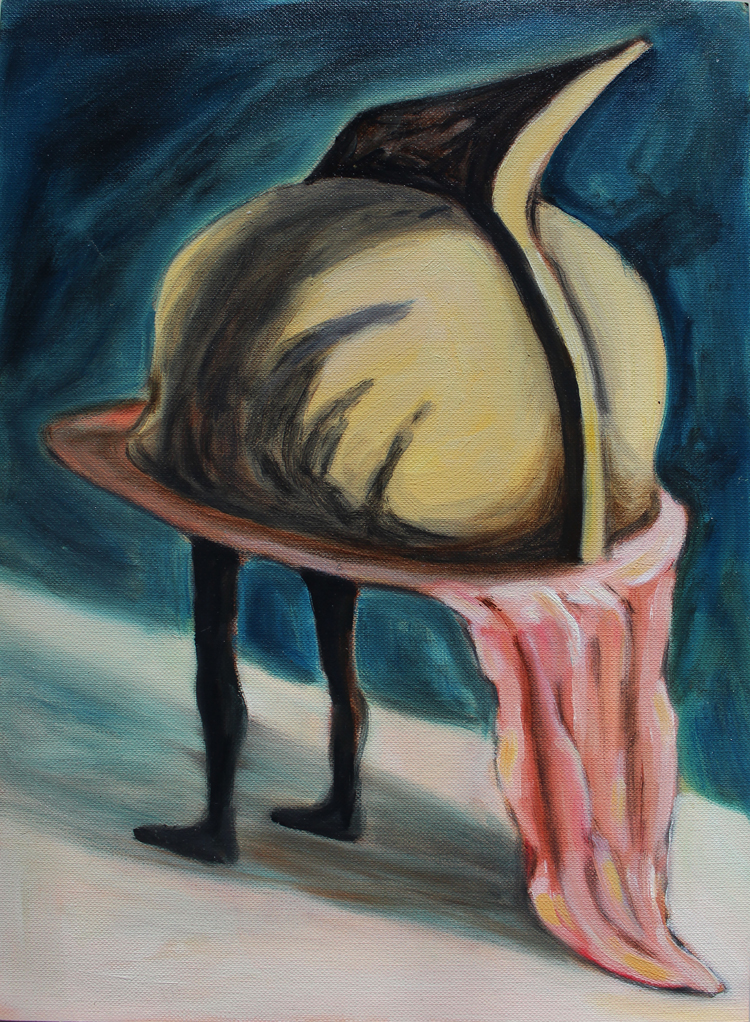
Prabhakar Pachpute. Museum Menageries (title for all the 40-paper works), 2020. Oil on paper
21 x 30 cm (each). Photo: the artist. Courtesy – the artist and Experimenter, Kolkata.
AMc: You mentioned research and reading. How site specific do your works tend to be, and how much are your ideas influenced by the venue and the history of the place for which the work is being made?
PP: It provides a lot of input. For example, I did some work for the São Paulo Biennial in 2014 and spent around two months in Brazil. I went to northern Brazil to do research into coal mining and iron mining. The people behind the biennial had also arranged for me to meet and talk to many people, and that input was very important, too. The elements I used in my drawing for the biennial were very specific and came from what I learned from the conversations: for example, the Brazilian coconut tree, which was a symbol of the collective monument created in 1999 by 800 survivors of the massacre of Eldorado dos Carajás to mark the place where 19 members of the Landless Movement died, and the vanishing or sacred mountains, which is something very specific to the place and its history. I would say it was the most important input, in fact – the stories, which I learned through that research.
AMc: You talked about your work initially being more about the landscape, but would you say now that it has become more about the people and the characters?
PP: “Landscape” is very cliched term, and I feel, whenever I am using it in my work, I really need to redefine the word very often. After six or seven years, I realised that the people, or the characters, which exist in my work, had somehow merged their identity with the landscape in a constant but vigilant transformation. The transformation of people, objects, geography, culture and migration is like silently moving clouds, which take different shapes as they move.
AMc: Are the characters very specific to their own location? For example, you would not have a character from a work based in India crop up in a work based in São Paulo?
PP: Not necessarily the character, no, but the type – the power that exists within them. There might just be changes in terms of what it is holding or what it is looking for. Also, many of them do not have a head, or it has been replaced by a tool, so they keep changing their identity according the place and their purpose.
AMc: Is there a narrative to your drawings and work more generally?
PP: Yes, there is a narrative and, most of the time, when I create a panorama or a drawing, it brings together many, many stories.
AMc: Can you say a little bit about surrealist influences and motifs that crop up in your work?
PP: I find surrealism quite alluring because it has a lot to do with the meaning of layers, metaphors and juxtaposition. When it comes to the aesthetic, it has a great combination of absurdity and beauty. For the past couple of years, however, I have been trying to create a new language, which is not just one of surrealism, but also a kind of abstraction. If you look at my recent sculptures or plywood cut-outs, they are more anamorphic or distorted forms. This approach to sculpture and drawing is quite new for me – thinking about the idea of form and the beauty of it.
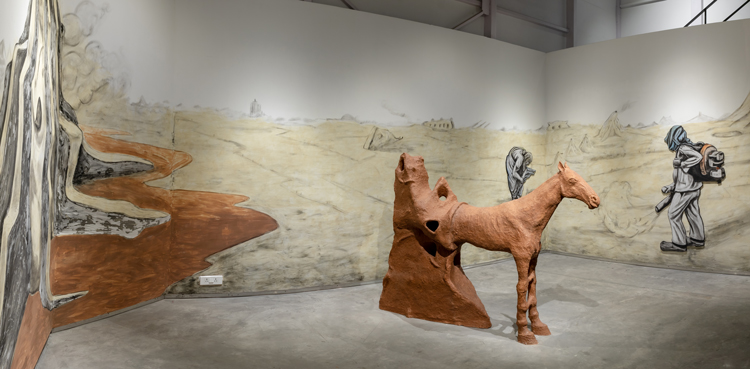
Prabhakar Pachpute. The underground nest over the dune (installation view), 2020. Rice husk, cloth, soil, red clay, Multani clay, gum Arabic, paper pulp, fenugreek seeds, cow dung, metal and wire mesh. Beneath the Palpable solo exhibition at Experimenter Ballygunge place, Kolkata. 2020. Photo: Experimenter, Kolkata.
AMc: What medium do you use to make your sculptures, primarily?
PP: I generally use clay and terracotta, but, for the last two years, I have been using plaster of paris, stone powder, Arabic gum, red clay, papier-mache, wire, multani clay, wood, rice husks and wire mesh.
AMc: What about your process for your wall drawings? You said they are your quick response, but do you sketch a small version first, or do you just go straight to the wall?
PP: I generally sketch a smaller version first, but it always changes on site. If I don’t have any plan or sketch, when I go to the venue, I spend couple of days sketching and developing the ideas for the work, also keeping in mind the site-specific elements. Spending time at the venue is always helpful for me. When you work on a larger scale, it automatically changes a lot.
AMc: You don’t use a projector, or scale up the sketch with a grid?
PP: No. I always do freehand drawings. Sometimes, I have to come back to a drawing more than 100 times, but I don’t have a problem with that process. I try to keep it free and spontaneous, so I can just explore the way I want.
AMc: Would you say there is a political element to your work?
PP: Yes, of course. When I talk about mining, there is a political aspect, alongside an economic and social one. The political, I suspect, is always there in my work. I look at migration, people coming from different places, and their work conditions. It’s also about the transition of the land: the transition of farming land into coal-mining land. I have always been interested in the concerns of the people and the concerns of the landscape. I also speak about consumerism and the consumption of resources a lot of the time, and that always becomes political, I think.
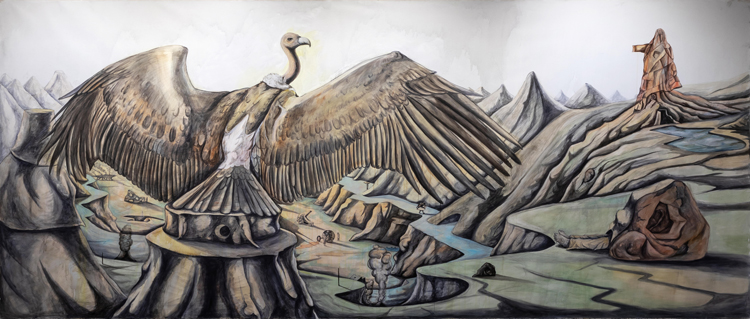
Prabhakar Pachpute. The relic of our time, 2020. Watercolour and acrylic paint on canvas, 84 x 192 in. Beneath the Palpable solo exhibition at Experimenter Ballygunge place, Kolkata. Photo: Experimenter, Kolkata.
AMc: You are one of the six shortlisted artists for Artes Mundi 9, the UK’s largest international contemporary art prize with £40,000 prize money. Can you tell me about the work you are planning for this exhibition?
PP: Two of the works come from Beneath the Palpable, my recent solo exhibition at Experimenter Gallery in Kolkata. It is all about the landscape and the degradation of human bodies, animal bodies and also the landscape itself. Part of it is concerned with the protests that are going on around the world, too. Right now, there is a huge protest in India, the farmers’ protest in Delhi, where farmers from the Punjab and Haryana and from many parts of the country have come together against three laws that have been passed. Two works specifically relate to these protests; to solidarity, opposition, negotiation, rejection and resistance. There are also a few new characters I have created. I recently started working with oil paint on paper. I had never done oil painting before, but it is something new from during lockdown, when I could not produce murals or sculptures, and I was looking for a different material for my drawings and paintings. I have created around 40 very small paintings – A4 size, on paper – and these will be shown all together. Finally, there are two works I produced specially for this exhibition, which deal with power in the mining and farming sectors, and also privatisation, which is happening all over India right now. These two paintings, and the small paintings, and the two other paintings, will create a kind of dialogue. Initially, of course, my plan was to go to Cardiff and do wall drawings, but the plan changed because of Covid-19.
AMc: Finally, what does it mean to you to be one of the shortlisted artists for Artes Mundi?
PP: When I found out I had been shortlisted, I was quite shocked. It came out of the blue. It is always inspiring to receive acknowledgment, which is also an immense boost in terms of motivation. I am very happy to be selected for this list of wonderful artists. I really admire these artists, so I am very thrilled to be part of the list.
• Artes Mundi 9 will open virtually on 15 March 2021, with the prize announcement on 15 April 2021.